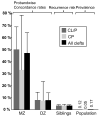Risk of oral clefts in twins
- PMID: 21423016
- PMCID: PMC3089024
- DOI: 10.1097/EDE.0b013e3182125f9c
Risk of oral clefts in twins
Abstract
Background: Small studies have indicated that twinning increases the risk of oral cleft.
Methods: We used data from a Danish national population-based cohort study to investigate whether twinning was associated with isolated oral cleft, and to estimate the twin probandwise concordance rate and heritability. Twins (207 affected/130,710) and singletons (7766 affected/4,798,526) born from 1936 through 2004 in Denmark were ascertained by linkage among the Danish Facial Cleft Database, the Danish Twin Registry, and the Civil Registration System. We computed oral cleft prevalence and prevalence proportion ratio for twins versus singletons, stratified for 3 subphenotypes. Probandwise concordance rates and heritability for twins were estimated for 2 phenotypes--cleft lip with or without cleft palate (CL/P) and cleft palate (CP).
Results: The prevalence of oral cleft was 15.8 per 10,000 twins and 16.6 per 10,000 singletons (prevalence proportion ratio = 0.95; 95% confidence interval = 0.83-1.1). This prevalence was similar for monozygotic and dizygotic twins. The probandwise concordance rate was higher for CL/P for monozygotic twins than for dizygotic twins (50% vs. 8%, respectively). A similar contrast was present for CP. Recurrence risk for both types of clefts was greater in dizygotic twins than in non-twin siblings. Heritability estimates were above 90% for both CL/P and CP.
Conclusions: No excess risk of oral cleft could be demonstrated for twins compared with singletons. The concordance rates and heritability estimates for both types of clefts show a strong genetic component.
Figures


References
-
- Harville EW, Wilcox AJ, Lie RT, Vindenes H, Abyholm F. Cleft lip and palate versus cleft lip only: are they distinct defects? Am J Epidemiol. 2005;162(5):448–453. - PubMed
-
- Mitchell LE, Christensen K. Analysis of the recurrence patterns for nonsyndromic cleft lip with or without cleft palate in the families of 3,073 Danish probands. Am J Med Genet. 1996;61(4):371–376. - PubMed
-
- Christensen K, Fogh-Andersen P. Cleft lip (+/- cleft palate) in Danish twins, 1970-1990. Am J Med Genet. 1993;47(6):910–916. - PubMed
-
- Christensen K, Fogh-Andersen P. Isolated cleft palate in Danish multiple births, 1970-1990. Cleft Palate Craniofac J. 1993;30(5):469–474. - PubMed
Publication types
MeSH terms
Grants and funding
LinkOut - more resources
Full Text Sources
Medical
Miscellaneous

